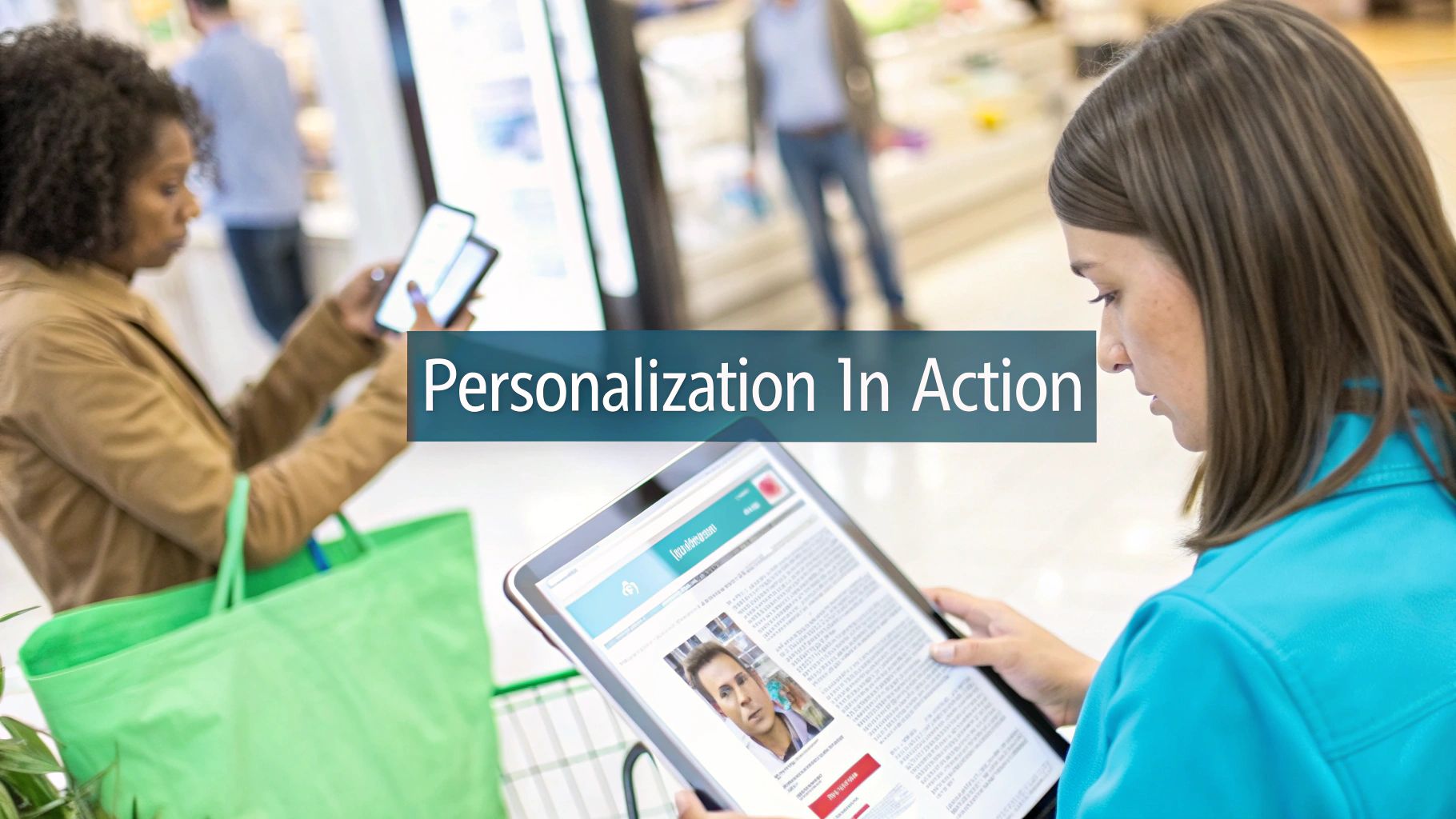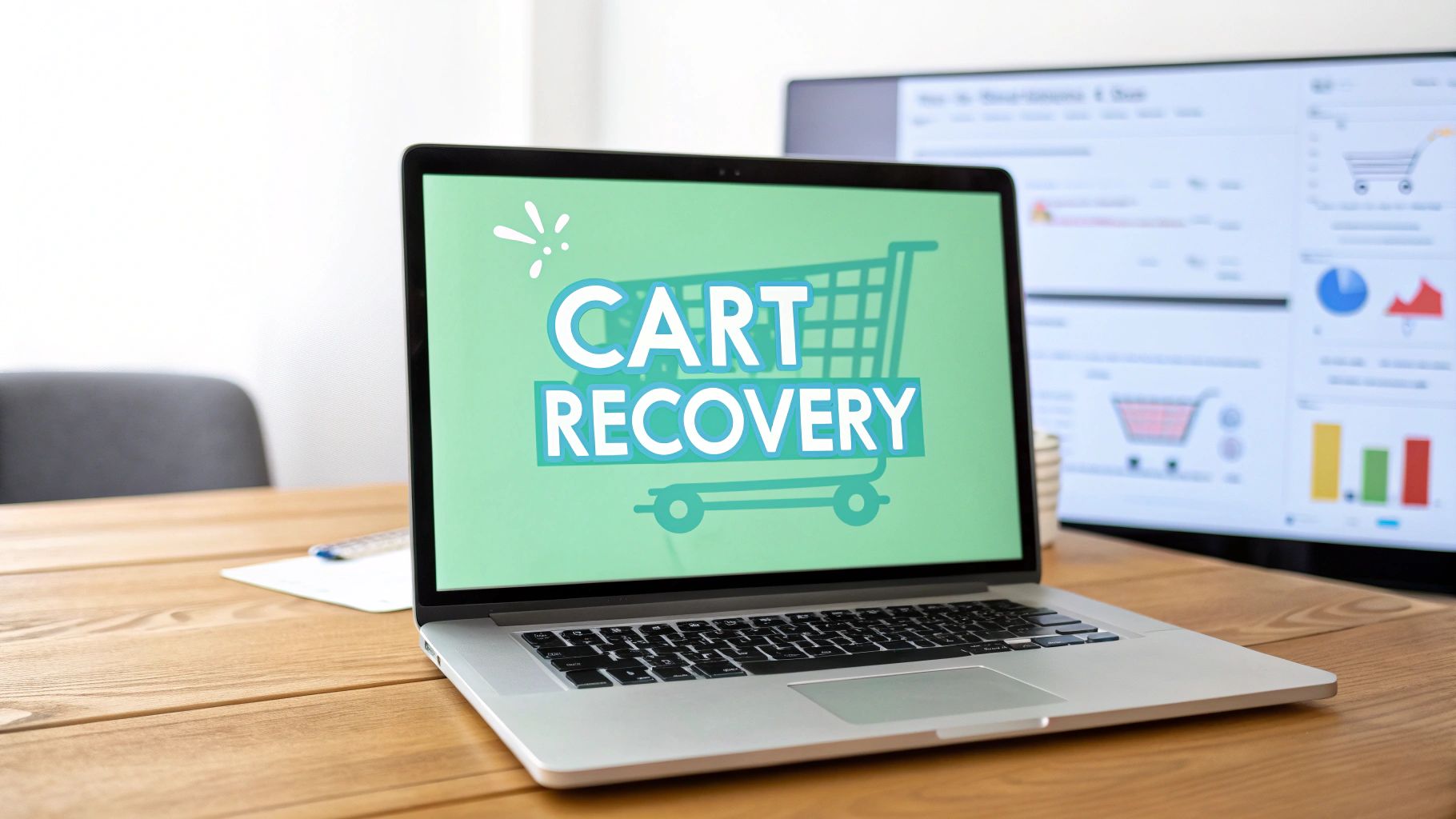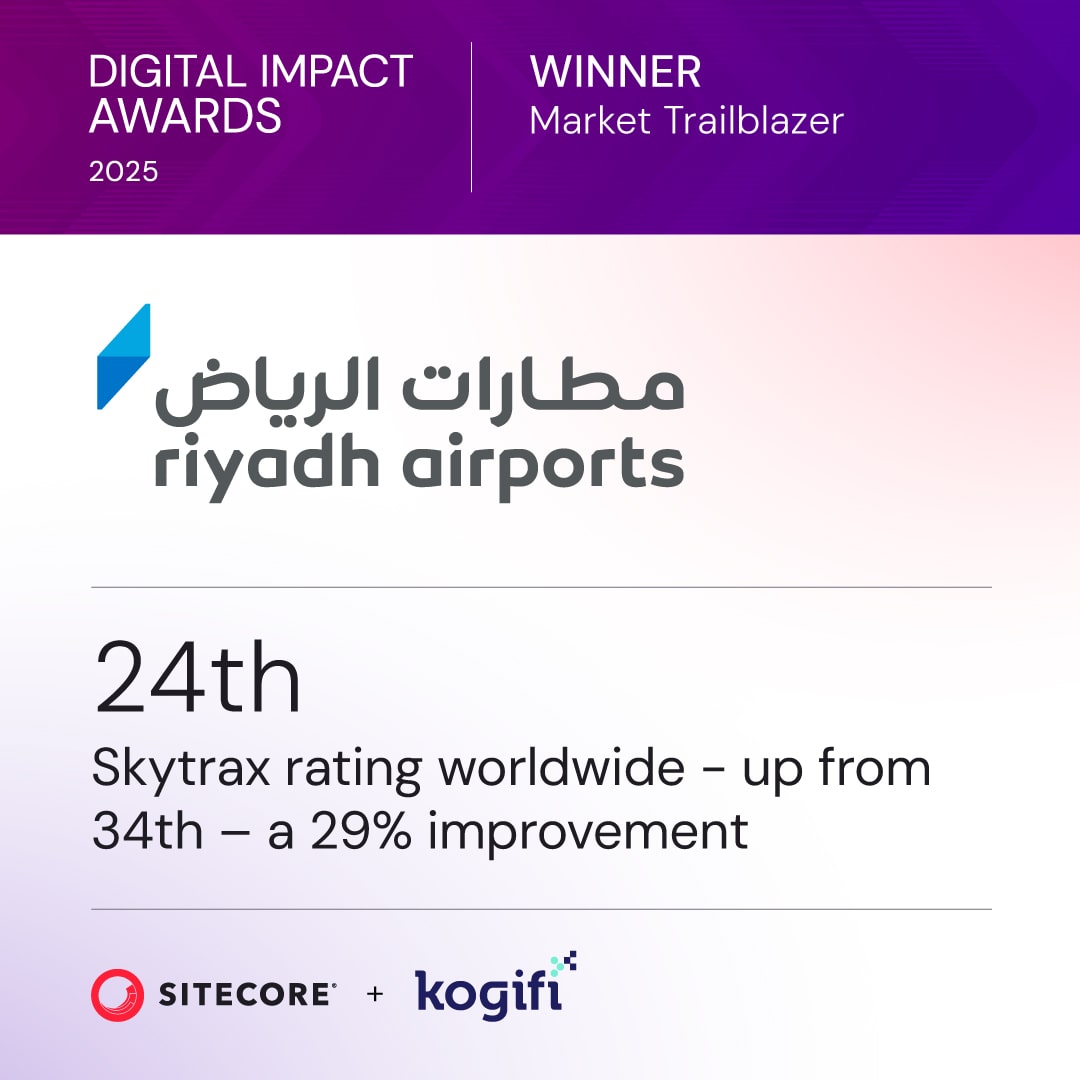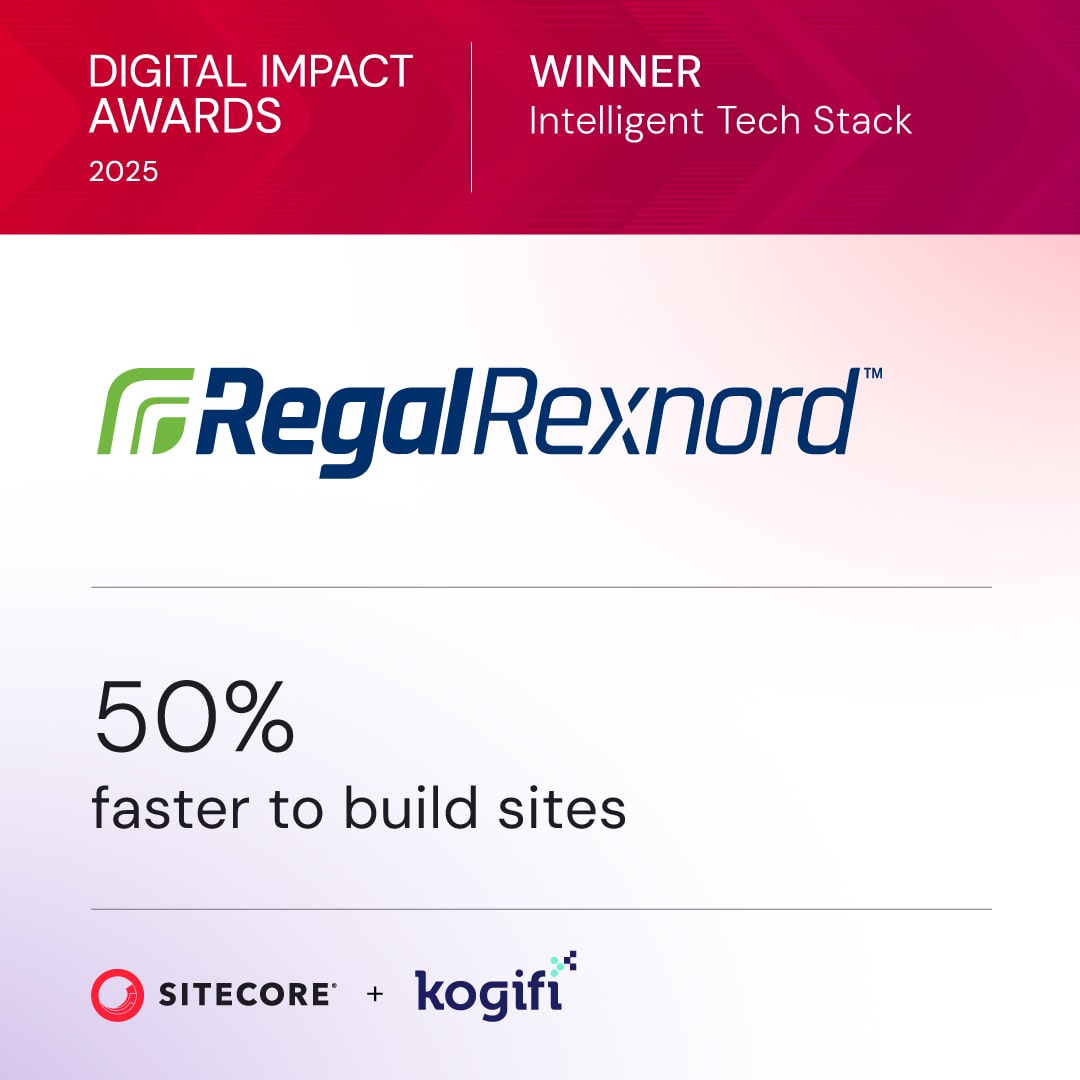Content personalization is the practice of leveraging customer data to tailor digital experiences for each individual user. It’s the core strategy for transforming a generic, one-size-fits-all website into a dynamic, one-on-one conversation, powered by robust platforms like Sitecore.
Instead of broadcasting the same message to everyone, personalization ensures each person sees the content, offers, and calls-to-action that are most relevant to their needs and intent.
What Is Content Personalization Really?

Think of your favorite local coffee shop. The barista knows your name, remembers your usual order, and perhaps even asks about a project you mentioned last week. That’s personalization in the real world—it’s relevant, builds rapport, and makes you feel valued.
Content personalization aims to replicate that feeling in the digital realm. It involves creating an online space that recognizes and adapts to each individual, moving far beyond simple segmentation. Instead of just grouping users by broad categories like location, it leverages behavioral data to understand what they truly want in the moment.
The Role of a Digital Experience Platform
This is where a modern Digital Experience Platform (DXP) like Sitecore becomes indispensable. A DXP acts as the central hub, connecting all the moving parts of a composable architecture to orchestrate these personalized moments seamlessly across the entire customer journey.
A powerful DXP can:
- Connect Content and Data: It brings your content—managed in a system like Sitecore XM Cloud—together with rich customer insights from a Customer Data Platform (CDP).
- Automate Engagement: With a unified view of the customer, it can trigger automated actions, like sending a perfectly timed email through a tool like Sitecore Send.
- Deliver Unique Experiences: The result? You can greet a returning customer with product suggestions based on their last purchase or automatically guide a new visitor toward helpful introductory guides.
Why Personalization Is No Longer Optional
Modern customers don't just appreciate personalization; they expect it as standard. A global survey found that a staggering 71% of consumers expect companies to deliver personalized interactions. The business impact is just as stark.
The same study revealed 76% are more likely to buy when content is personalized, and 78% are more likely to become repeat customers for brands that get it right.
Personalization is the difference between broadcasting a message to a crowd and having a meaningful conversation with an individual. It transforms the user experience from transactional to relational, building the foundation for long-term loyalty.
However, the risk of getting it wrong is significant, as the study also found that 77% of consumers feel frustrated by irrelevant promotional messages. This underscores the need for a smart, data-driven strategy rather than guesswork.
Ultimately, one of the core goals is to improve customer engagement by making every touchpoint count. Even internal platforms like SharePoint use these same principles, targeting news and documents to employees based on their department or role to boost internal productivity.
The Data Engine That Fuels Personalization
Think of a personalization engine as a high-performance race car. Its power is useless without the right fuel. In content personalization, that fuel is high-quality, unified data. Without a steady stream of clean, actionable insights, even the most sophisticated DXP like Sitecore will sputter and stall.
Great personalization isn’t magic; it’s built on a deep understanding of the customer. This understanding is achieved by collecting and unifying information from every touchpoint—website clicks, abandoned carts, in-store visits, and customer service calls. This is precisely where a Customer Data Platform (CDP), like the one within Sitecore's composable DXP, becomes invaluable.
A CDP’s main job is to act as a central hub, demolishing the data silos that naturally form across an organization. It ingests data from disconnected systems and stitches it together to create a single, coherent customer profile that is updated in real time. This unified view is the bedrock of any effective personalization strategy.
The Three Core Data Types
To build that complete customer profile, you need to gather three distinct kinds of data. Each one offers a different piece of the puzzle, and when you put them together, you get a rich, multi-dimensional view of your audience.
These core data types are:
- Explicit Data: This is information users willingly and directly provide. Think of form submissions, survey responses, or preference center selections. It’s incredibly valuable because it clearly states a customer's needs or identity.
- Implicit Data: This is information gathered by observing a user's behavior. It includes actions like which pages they visit, how long they stay, the links they click, and the content they download. This behavioral data is a powerful clue to a user’s immediate intent and interests.
- Contextual Data: This is all about the user's environment at the moment of interaction. It includes details like their device (mobile vs. desktop), geographic location, the time of day, and even the local weather.
Unifying Data for Actionable Insights
No single data type tells the whole story. The real power is unleashed when you combine them. For instance, knowing a user is on their phone (contextual) and has been looking at pages about winter coats (implicit) allows a platform like Sitecore to serve up a "Mobile-Only Flash Sale on Outerwear."
This process turns raw data points into smart, actionable intelligence. The entire foundation of effective content personalization rests on this comprehensive data collection. Behavioral data is particularly crucial; it's no surprise that around 90% of companies now use AI technologies to analyze these signals for better accuracy and scale, a trend highlighted on optimonk.com.
A first-party data strategy is no longer a "nice-to-have"—it's a core business asset. By focusing on data you collect directly from your audience, you build a reliable, privacy-compliant foundation that fuels every personalization decision, ensuring each interaction is based on real-time truth, not guesswork.
This unified approach is essential for building detailed user segments. For example, on a corporate SharePoint intranet, you could create an audience of "Sales team members in the EMEA region" by combining explicit data (department) with contextual data (location) to deliver targeted sales reports. If you're looking to dive deeper into this topic, you can learn more about segmentation in AI-driven personalization in our guide.
Ultimately, a robust data engine is what separates generic, one-size-fits-all marketing from a truly personal connection.
How Personalization Actually Works
To understand what content personalization is, you need to look under the hood. There are two primary engines driving it: a manual, rules-based approach and a more advanced, AI-driven one.
Imagine navigating a new city. You could use a detailed, turn-by-turn map that you've meticulously planned out yourself. Alternatively, you could use a smart GPS that finds the best route in real-time, adapting to traffic as it happens.
Both methods get you to your destination, but they are built for different scenarios. Let's explore how each works, particularly within powerful platforms like Sitecore and SharePoint.
The Precision of Rules-Based Personalization
Rules-based personalization is the hands-on approach where the marketer or content author defines the logic. It operates on a straightforward "if-then" framework. You define the "if" (the condition) and the "then" (the action), giving you complete control over the user experience.
This is the perfect starting point for any organization. In Sitecore's Rules Engine, for instance, you can set up these conditions without writing a single line of code.
Here are a few real-world examples of how this logic plays out:
- If a visitor is from a specific country, then show them a banner with local shipping deals.
- If a user has visited the pricing page three times this session, then display a pop-up offering a free consultation.
- If a user lands on your site from a specific marketing campaign, then change the main hero image and headline to match the ad they just saw.
This method is also a cornerstone of internal communications in SharePoint. An administrator can use audience targeting to set a rule: If an employee is part of the "Sales" group, then show them the latest quarterly sales report on their intranet homepage. This cuts through the noise and ensures people see what is relevant to them.
The real power of a rules-based system is its predictability. You craft the exact experience you want for specific, well-defined user segments, making it an indispensable tool for targeted campaigns and achieving your first personalization wins.
The Power of AI-Driven Personalization
While rules-based logic is effective, it has scalability limits. Attempting to create a unique rule for every user action is impossible. This is where AI-driven personalization, the smart GPS of digital experience, takes over.
Platforms like Sitecore Personalize and Sitecore Discover leverage machine learning algorithms to analyze massive amounts of data in real time. Instead of waiting for manual instructions, the AI learns from user behavior to predict what someone wants and automatically serves up the most relevant content.
This automated system doesn't need to be told what to do; it figures it out on its own by analyzing clicks, searches, and purchase histories to spot patterns a human would miss. A classic example of this in action is understanding what is retargeting in digital marketing, where tailored ads follow users based on their previous website interactions.
This infographic breaks down the different kinds of data that fuel both personalization engines.
By weaving together explicit, implicit, and contextual data, these platforms build a rich user profile that makes truly relevant experiences possible.
For an e-commerce site using Sitecore Discover, the system can automatically suggest the perfect product—not because of a rule you wrote, but because it has learned which items are frequently bought together by customers with similar tastes. It surfaces the most relevant content and offers for thousands of individuals at once. For a deeper look at the strategy behind this, check out our guide on personalization on the web.
Think of it this way: rules-based personalization is your strategic starting point. It helps you gain control and learn about your audience. But AI is what you need to achieve true one-to-one personalization at scale, creating experiences that would be impossible to map out by hand.
Putting Personalization into Practice
Theory is one thing, but seeing personalization drive actual business results is where things get interesting. Let's shift from concepts to real-world applications. We'll examine how powerhouse platforms like Sitecore and SharePoint turn data into tangible experiences, showcasing how the same principles apply differently to external customers versus internal employees.

We’ll start with customer-facing scenarios where revenue and loyalty are the primary goals, then pivot to internal use cases designed to boost productivity and engagement.
Driving Customer Revenue with Sitecore
The entire Sitecore ecosystem is engineered to translate customer insights into personalized actions that directly impact the bottom line. Its composable suite of products gives businesses the tools to build incredibly specific and dynamic journeys for every single visitor.
Take a large e-commerce retailer aiming to increase average order value (AOV) and reduce cart abandonment. Using Sitecore Discover, they can deploy an AI-driven engine that analyzes a shopper's real-time behavior—every click, search, and item added to the cart.
- Scenario: A customer adds a high-end camera to their cart.
- Sitecore Discover Action: The AI instantly predicts related products this specific user is likely to buy, such as a compatible lens, a memory card, or a camera bag, and features them prominently on the page. This isn't a generic "people also bought" list; it's a recommendation built for that user's unique profile and browsing history.
- Result: The customer adds the suggested lens, boosting the AOV by 30%. The experience feels helpful and intuitive, not pushy, which builds genuine brand affinity.
Now, consider a university trying to increase student applications. They can use Sitecore XM Cloud for content delivery and Sitecore Personalize to orchestrate the entire admissions journey.
- Scenario: A prospective student from California downloads a brochure for the computer science program.
- Sitecore Personalize Action: The next time they visit, the homepage hero image is a shot of the state-of-the-art tech lab. The featured "student stories" are all from computer science majors, and a banner pops up inviting them to a virtual campus tour hosted by the engineering department.
- Result: The prospect feels seen and understood. They see a clear path for their interests, making them far more likely to click "apply now."
By connecting content with real-time behavioral data, Sitecore empowers organizations to move beyond static web pages. It helps them create fluid, responsive experiences that anticipate user needs and guide them toward a desired outcome, whether that's a purchase or an application.
Boosting Employee Productivity with SharePoint
The principles of what is content personalization are just as powerful when applied internally. A corporate intranet built on SharePoint can be transformed from a cluttered document repository into a streamlined productivity hub by using audience targeting. The goal here isn't to sell a product, but to deliver the right information to the right employee at the right time.
For a global corporation, an employee in the German sales division needs completely different information than an HR manager in the United States. SharePoint allows administrators to tailor the intranet experience based on attributes already stored in user profiles, such as department, location, and role.
This approach flips the script on how intranets are used, shifting from a passive content repository to an active, helpful tool. The table below illustrates the different applications of personalization.
Personalization Use Cases Sitecore vs SharePoint
By tailoring the digital workplace, companies cut through information overload. Employees can find what they need in seconds, enabling them to focus on their core tasks. It’s a clear demonstration that with the right content personalization software, the same fundamental strategy can be adapted to achieve distinct and valuable business goals, regardless of the audience.
Measuring the Business Impact of Personalization
Content personalization should be viewed as an investment, not an expense. To secure leadership buy-in and scale your efforts, you must connect every rule, test, and AI-powered recommendation directly to the bottom line. It's about building a solid business case that proves how relevant, timely experiences translate into more revenue, deeper loyalty, and a smarter marketing spend.
Within the Sitecore ecosystem, measurement is an integral part of the platform. Its analytics are designed to provide a clear, honest view of what’s working and what isn't. You can directly track how your personalization rules, A/B tests, and AI recommendations are changing user behavior, allowing you to move past vanity metrics and focus on what truly matters.
Key Performance Indicators to Track
To prove the return on your investment (ROI), you must track the right Key Performance Indicators (KPIs). These metrics speak the language of business value, showing tangible improvements that leadership can understand and support.
Your go-to KPIs should include:
- Conversion Rate Lift: This is the ultimate proof. Using Sitecore’s analytics, you can compare the conversion rates of personalized experiences against a control group to isolate the exact uplift your efforts are generating.
- Average Order Value (AOV): For e-commerce, it’s critical to track how AI-driven product recommendations from a tool like Sitecore Discover increase the average transaction size.
- Reduced Bounce Rates: When visitors land on a page that immediately speaks to their needs, they’re far more likely to stick around. A lower bounce rate is a strong indicator that your personalization is making a positive first impression.
- Improved Customer Lifetime Value (CLV): This is a long-term play. CLV demonstrates how personalization builds loyalty over time, encouraging repeat purchases and a deeper relationship with your brand.
Building Your Business Case with Data
The numbers don't lie: a well-executed personalization strategy is a powerful revenue driver. Companies that personalize their web experiences see an average sales increase of 19% and a 40% jump in order value. Even more telling, fast-growing companies generate 40% more revenue from personalization than their slower-moving peers. You can discover more insights about personalization statistics on Instapage to see the full picture.
The goal is to shift the conversation from "How much does personalization cost?" to "How much revenue is our personalization strategy generating?" By consistently tracking and reporting on these core KPIs, you prove its value and justify further investment.
This isn't just for e-commerce. On an internal platform like SharePoint, you can also measure success. Instead of AOV, you might track time-on-task for finding documents, scores on employee satisfaction surveys, or adoption rates for new tools promoted through targeted banners. This demonstrates how personalization boosts internal productivity and engagement, proving its value across the entire business.
Navigating Privacy and Building Trust
In a data-driven world, audience trust is your most valuable asset. Great personalization strikes a delicate balance: delivering a genuinely helpful experience without ever making people feel their privacy is being invaded. Today, this is not just good practice; it's a legal necessity due to regulations like GDPR and CCPA.
These laws have fundamentally changed how companies handle customer data. They demand transparency, require user consent, and hold businesses accountable for being good stewards of the information they collect. This is why modern platforms like the Sitecore DXP are engineered with privacy at their core, providing the tools to manage consent and respect user choices across your digital ecosystem.
Building Confidence Through Transparency
The secret to ethical personalization is creating a clear value exchange. People are much more willing to share information when they see a direct benefit—when they understand how you’ll use it to make their lives easier. The goal is not to hide details in complex legal text but to be upfront about the mutual benefits.
This is where zero-party data comes in. It’s information that customers willingly and proactively provide, such as preferences set in a profile, survey answers, or topics they choose to follow. This data is incredibly powerful because it comes with explicit consent and clear intent, building your personalization strategy on a solid foundation of trust.
Ethical personalization isn't just about legal compliance; it's the foundation of a lasting customer relationship. When users feel secure and in control, they share data not because they have to, but because they know it leads to a genuinely better, more helpful experience.
Privacy by Design in Practice
Platforms built with privacy in mind offer features that make compliance far less of a headache. For example, Sitecore CDP provides robust consent management tools that let you capture and respect user permissions at every single touchpoint. This ensures your personalization rules only fire for users who have opted in, protecting their privacy and your brand’s integrity.
This principle extends to internal tools as well. On a SharePoint intranet, respecting employee privacy is non-negotiable. Personalizing content for different departments is a powerful strategy, but it should always be based on defined roles and professional data, never private information.
Ultimately, the goal is to personalize without compromising anonymity, a strategy that builds trust both with your customers and your own team.
Unpacking Content Personalization: Your Questions Answered
As teams begin to explore what content personalization really means, a few key questions inevitably arise. Clarifying these points can resolve confusion and help shape your strategy, whether you're using a powerful DXP like Sitecore or an internal hub like SharePoint.
Personalization vs. Customization
While often used interchangeably, these terms describe different actions. The key distinction lies in who is in control.
Personalization is when the system does the work. The platform—whether using the Sitecore Rules Engine or AI from Sitecore Personalize—automatically adapts the experience for the user based on their data. An e-commerce site showing you products similar to those you’ve viewed is a classic example. You didn't request it, but the system anticipated your needs.
Customization, on the other hand, is driven by the user. They manually adjust settings to match their preferences. A perfect example is switching an app to dark mode or rearranging widgets on a dashboard. The user is in full control.
How Do I Start with Limited Data?
This is a common concern. It's a myth that you need vast amounts of customer data to begin. The truth is, you can start with what you already have: context.
You don't need deep behavioral profiles to deliver value right away. Contextual personalization—based on things like a visitor's location, device, or how they got to your site—is the perfect entry point. It delivers quick wins and kicks off the data collection you'll need for more advanced strategies down the road.
With a platform like Sitecore, you can set up simple but effective rules without any historical user data. For instance, you could show a different homepage banner to visitors who clicked through from a specific marketing campaign. Or you could display content in Spanish for anyone visiting from Mexico. Each interaction helps build the behavioral data you'll use for more sophisticated, profile-based personalization later.
Can You Personalize a SharePoint Intranet?
Absolutely. While an internal SharePoint intranet serves a different purpose than a customer-facing DXP, it can and should be personalized. SharePoint has a powerful feature called audience targeting.
This allows you to control who sees specific content. You can configure it so that an employee in the Sales department sees a completely different homepage than someone in Engineering. News, documents, and navigation links can all be tailored to specific roles or teams. This is an effective way to cut through information overload, making the intranet a genuinely useful tool that helps everyone work more efficiently.
At Kogifi, we specialize in implementing advanced personalization strategies on platforms like Sitecore and SharePoint to drive meaningful results. Contact us to transform your digital experience.








































